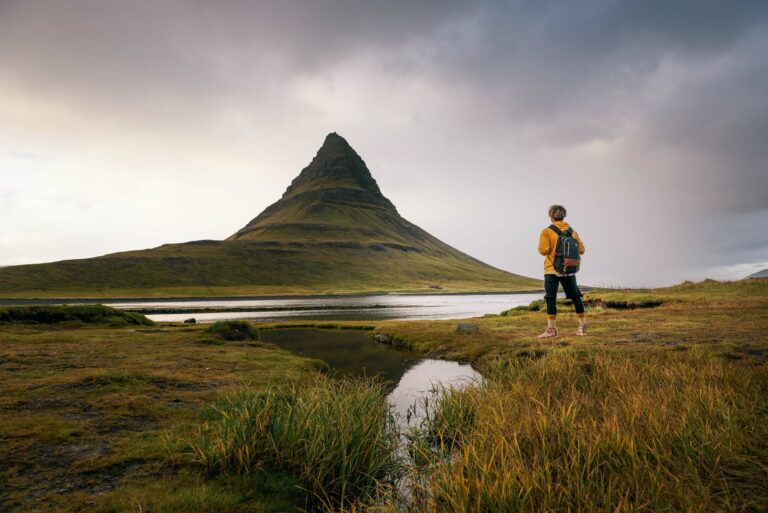The Hexagonal Pillars of Gerduberg Basalt Columns in Snaefellsnes
- Snaefellsnes, West Iceland
- 15 Jul 2023
In the diverse landscape of Iceland, you find the Gerðuberg Cliffs, a striking example of nature's artistry with its symmetrical basalt columns. These geological formations stand as a testament to volcanic activity, telling stories of an ancient fiery past. In this exploration of the Gerðuberg Basalt Columns, let me take your focus to the geological formation and the distinct characteristics of Gerduberg basalt rocks.

What Do Gerduberg Cliffs Look Like
Gerduberg Cliffs, located in the picturesque landscapes of West Iceland, are a natural geological wonder that never fails to astonish. These towering cliffs, composed of basalt columns, rise dramatically from the earth, and in the hexagonal shapes that resemble enormous organ pipes, together forming a striking visual spectacle.
With their dark, majestic tones and sheer grandeur, Gerduberg Cliffs offer a profound glimpse into the Earth’s transformative processes, making them a must-visit destination when you travel to the Snaefellsnes Peninsula of Iceland.

How Was Gerduberg Basalt Columns Formed
The impressive sutures of the hexagonal basalt columns at Gerðuberg were formed through the cooling and contraction of lava. The lava erupted and then cooled relatively quickly, contracting in such a way that it created patterns of cracks or joints. Over time, these joints propagated, resulting in the hexagonal pillars we observe. These pillars can vary in size, but their symmetrical geometry is a hallmark of this natural process.

What’s So Special about Gerduberg Basalt Columns
Basalt, a type of dolerite, is the bedrock of these columns. It’s a coarse-grained, igneous rock made up largely of plagioclase and pyroxene minerals, often featuring a glassy appearance. Basalt rocks are known for their durability, which allows the columns at Gerðuberg to stand against the harsh weathering forces of nature. The rock’s dark color and texture not only contribute to the columns’ aesthetic appeal but also serve as a testament to the rock’s volcanic origin.

Where is Gerduberg Basalt Columns Located
Gerðuberg Cliffs are situated on the southern edge of the Snæfellsnes Peninsula, an area celebrated for its natural beauty. Access to these cliffs is straightforward; they are conveniently located just off Highway 54, which makes them easily reachable by car from Reykjavík in about two hours. For those navigating the region, signs will guide you from the highway onto a gravel road, leading directly to the cliff’s base.

The Best Viewpoints to See Gerduberg Basalt Columns
The view from the Gerðuberg Cliffs is nothing short of spectacular, with sweeping panoramas of the peninsula and the sea. Photographers will appreciate the array of compositions available, with the hexagonal patterns of the columns providing a compelling foreground against the vast Icelandic landscape. The cliffs offer multiple angles and positions from which to capture their magnificence, ensuring that the resulting photos encapsulate the essence of this remarkable geological feature.

Wildlife and Plantlife
Exploring the Gerðuberg Basalt Columns offers you more than just a geological marvel; the area is also a sanctuary for various species of wildlife and hosts a range of hardy plant life. We encounter this natural mosaic as we navigate through the landscape where the intricate balance of nature is evident.

Birds and Mammals
Birds: The cliffs provide a habitat for a variety of bird species. Given the cliffs’ lofty nature, they are an ideal vantage point for birds of prey such as gyrfalcons. Seabirds often frequent the area, and we may spot kittiwakes or guillemots using the columns as nesting sites.
Mammals: Although mammals are less visible in this landscape, the Arctic fox, being Iceland’s only native land mammal, sometimes makes an elusive appearance in search of food.

Local Plant Species
Berry Bushes: As we survey the flora, we often find bushes of bilberries, blueberries, and crowberries. These berries are not only a feast for our eyes but are also integral to the local ecosystem, providing nourishment for birds and small mammals.
Other Vegetation: The plant life here is predominantly low-lying due to the harsh Icelandic climate. Mosses and hardy grasses form a lush carpet in the summer months, while lichens cling to the columns, adding to the area’s rich biodiversity.





















